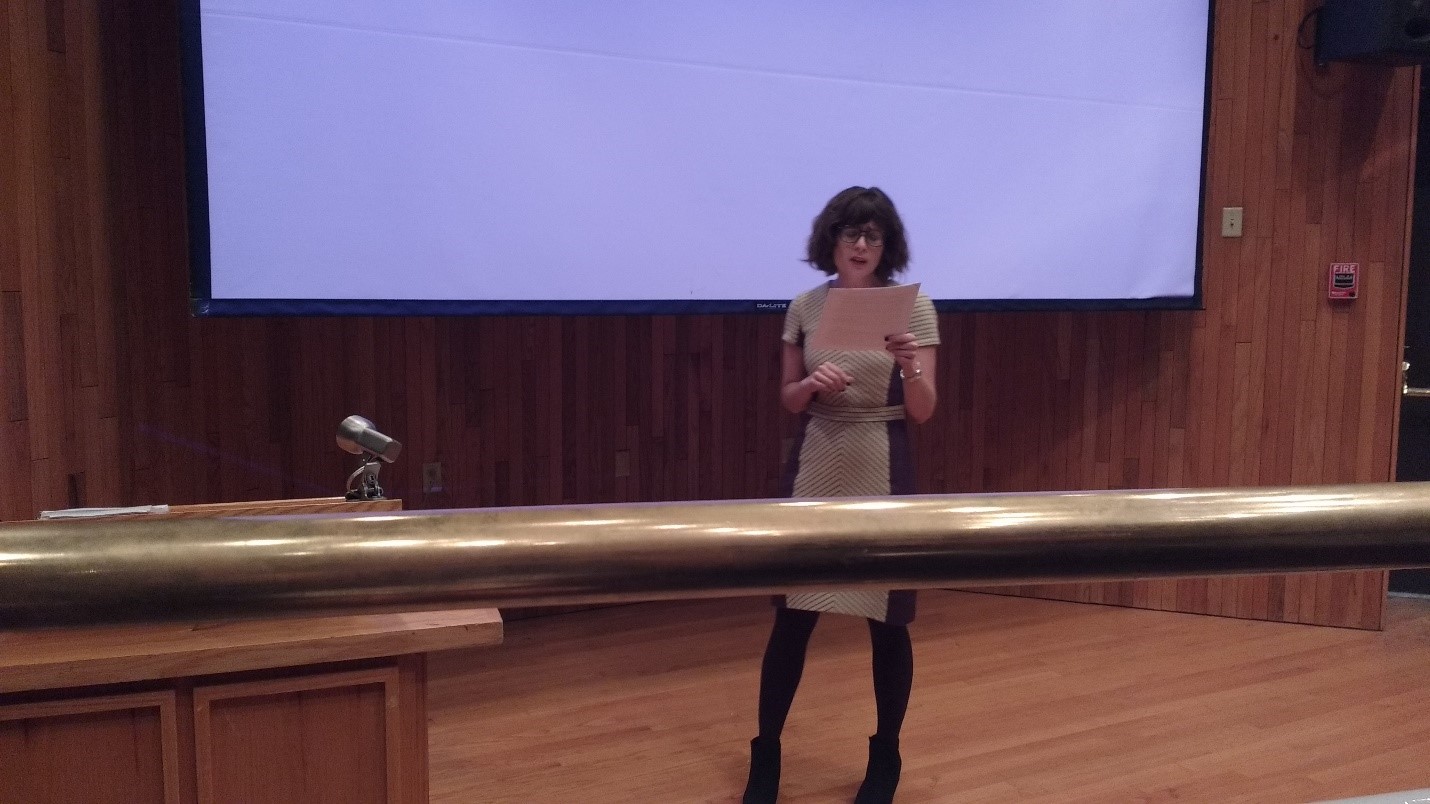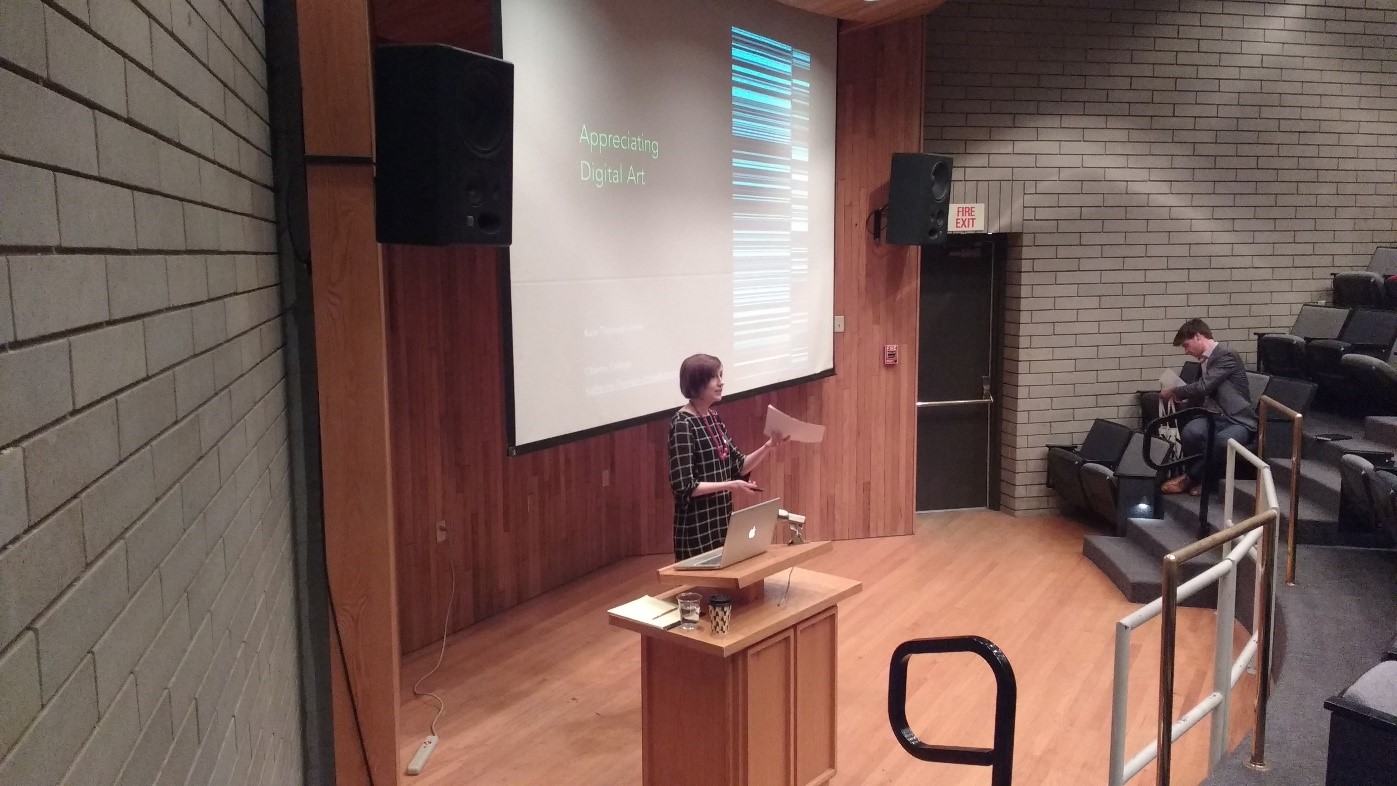Mary-Beth Willard (Weber State) offers pseudo-live-blogging/recap/latergram of
the Art Rules Conference, Day 2
I’ve found (n = a few) that aesthetics conferences have some of the best philosophical audiences and discussions. I am not sure why this has been the case – the small size of the subfield? The somewhat more interdisciplinary nature of aesthetics? Whatever the reason, the participants at Art Rules were no exception. Discussion has been great.
Day Two of the Art Rules conference began with coffee and pastries from Les Madeleines (the first bakery west of the Mississippi to offer the kouign-amann pastry!).

The auditorium at Salt Lake’s UMOCA is small, steeply angled, and has great acoustics, perfect for speaking.
Or, as in the opening talk of the second day, introducing the assembled to the end of Lehnhoff’s production of Parsifal:
Andrew Huddleston (pictured below, “Meta-Normativity in the Philosophy of Art”) led off by introducing a distinction crucial to developing work in meta-normativity in art. Questions such as “Is it appropriate to stage Parsifal so that the character Kundry survives?” are ambiguous between two interpretations. Taken as a practice-internal question, it means something like “Do current staging norms permit such a change in an opera?” Taken as a practice-external question, it means something like “Should staging norms permit these changes?” Answering practice-internal questions are akin to answering questions about etiquette; they can be answered by learning about sociological facts and internal norms. Answering practice-external questions is where we might find philosophical investigations into meta-normativity.

Samantha Matherne (pictured below, “Aesthetic Autonomy and Norms of Exposure”) tackled Kant’s theory of aesthetic autonomy. There is an apparent tension between aesthetic autonomy, according to which we must rely only on ourselves and not the opinion of others when evaluating a work of art, and norms of exposure, the Humean idea that to make aesthetic judgments appropriately, we must appropriately cultivate our evaluative capacities first, by being exposed to works of art (and presumably the polluting judgments of others, the norms, and so forth.) Kant is often read as holding that only the aesthetic neophyte can have true aesthetic autonomy (the young poet of the 3rd Critique), but she argues that exposure is a precondition to making proper aesthetic evaluations; the ability to have aesthetic autonomy must be developed.

Lunch today: at Chile-Tepin
Levi Tenen (“Why We Shouldn’t Preserve Nature For Aesthetic Reasons”) argues that the structure of aesthetic normativity renders aesthetic reasons unsatisfactory for justifying environmental protection. I am missing a snapshot of Levi in action (sorry, Levi!), but let me substitute a snapshot that illustrates the kind of puzzle he has in mind, as well as one that illustrates some of the natural beauty of northern Utah.

This shot is from the Sunday after the conference, atop Buffalo Point on Antelope Island in the Great Salt Lake. (Hashtag no filter, hashtag Utah looks this good even with a crappy phone camera.) If we value the environment aesthetically, Levi argues, we are committed to valuing that people have direct sensory experience with it. To preserve the environment, however, always involves restricting access to it, sometimes, as in the case of particularly fragile ecosystems or natural features, by restricting access entirely. Levi concludes that we cannot consistently deny access to the environment based on its aesthetic merit and hold that it is valuable because of its aesthetic merit. Never fear – this move makes room for his preferred historical-etiological defense of environmental preservation. We should preserve the environment, but aesthetic reasons aren’t good (or good enough) reasons for doing so.
Katherine Thomson-Jones (“Appreciating Digital Art”) was invited to speak about some of the themes in her upcoming book Digital Aesthetics. Digital art is any art in a digital medium, or that integrally uses computer code. This covers a wide range of artworks, in areas as seemingly diverse as digital films and photographs, digital acoustic art, and wonderfully nerdy binary art installations. Even a mirror made of trolls (Troll Mirror, Daniel Rozin):
Katherine (pictured below) argues binary code and its artistic uses constitute the medium of digital art, and that understanding the digital medium as an artistic medium allows us to realize commonalities among diverse artworks, informing our proper appreciation of digital art.

For example, consider editing film. Digitalization was supposed to make editing easier by streamlining the editing process – if a director wants to shade the entire film subtly blue, that can be done with the click of a button. But as it turns out, digitalization was also accompanied by a massive increase in the volume of material to be edited, meaning that the editor in search of a perfect shot now must do much more work than before. Recalcitrant problems are recalcitrant no more, but they’ve been replaced by new challenges. Artists must also now make decisions about how replicable their art will be, because digital art is theoretically infinitely reproducible. Katherine concludes that appreciating digital art properly requires understanding digital art as a medium.
The final talk, and final invited talk, featured Nick Riggle (pictured below, “Aesthetic Necessity”), who asks us to consider aesthetic necessity, where an aesthetic judgment is taken as a “must”. You must hear this aria; you must not wear those pants with that shirt. Nick invites us to consider the following case: Imagine going to an ice cream shop and placing an order for a double scoop of lemon and peanut butter. The server refuses – he won’t serve you such an awful combination. How should we understand this, and how should you respond to the server?

We might hear the server as if he were Kant, dictating his preferences to us, by insisting that his ice cream preference has universal validity. Or, he might be like Proust, preferring to enjoy his ice cream alone, without our intrusion (probably beneath the flowering hawthorns.) No! Instead, we should understand his judgment as expressing his individuality, and we should respond in kind –
– And if everything goes well, we find a shared community of like-minded individuals, as we did in Salt Lake City.
This is Part 2 of a two-part series. For Part 1, click here.
Notes on Contributor:
Mary-Beth Willard is Assistant Professor of Philosophy at Weber State University. She works in metaphysics, aesthetics, and early modern philosophy, and has particular interests in street art.

